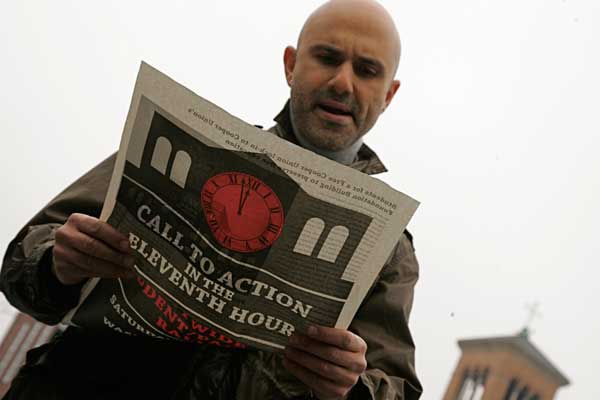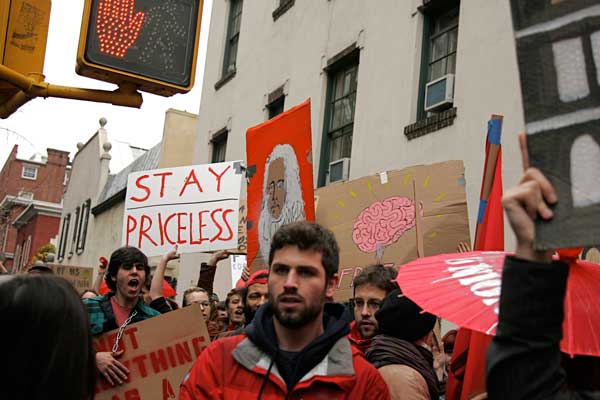
BY SAM SPOKONY | They descended from a tower — but, perhaps, not one of ivory.
And as the 11 Cooper Union students who’d locked themselves inside the top of the elite college’s Foundation Building finally emerged on Monday, after a weeklong occupation, it was the embraces of their peers and fellow protesters that finally brought them back to earth.
“It was strange looking out that window, looking down and seeing people cheering,” said John Cuba, a 20-year-old art student, between the hair tussles and shoulder grabs offered by smiling friends. “It was weird… . I kept forgetting we were actually at Cooper.”
A surreal experience, to be sure, and one that the protesters — who aim to prevent the financially struggling college from following through on its administration’s plans to begin charging tuition next year — believe was also a successful one.
After they’d barricaded themselves inside the building’s historic clock tower on Dec. 3, the occupiers proclaimed their three demands: The administration should reaffirm Cooper Union’s mission statement (which says that the college provides full-tuition scholarships for all enrolled students); there should be greater transparency in the college board of trustee’s decision-making process; and, finally, that President Jamshed Bharucha should step down.
Cooper Union has not yet acquiesced to any of those demands. But protesters believe that their highly vocal presence over the past week, in addition to the occupation, has won them a moral victory. It’s also drawn professors, alumni and students from other schools in support of their cause, along with coverage by the mainstream media.
And after the occupiers walked out on Monday, the students collectively reiterated that they’ve already taken the third demand into their own hands — by declaring that they no longer recognize Bharucha as their school’s president.
“It feels like being in that room has done what it needed to do, in that everyone outside has kind of come together, and we all have a common idea of what needs to happen,” Cuba said.
Monday’s events followed a hundreds-strong rally that took place on Saturday, which saw a group of student protesters, alumni and Occupy Wall Street activists march from Washington Square Park to the foot of the Foundation Building in Cooper Square.
Cooper Union was founded by inventor and industrialist Peter Cooper in 1859. It’s currently one of only a handful of institutions of higher learning in the country that offers a free education.
According to the college’s press office, the policy on full-tuition scholarships for all students began in 1902, when a large endowment was received. Before that, students who could pay their tuition did so.
But Professor Peter Buckley, who teaches history at Cooper Union and acts as the college’s unofficial historian, clarified the school’s statement regarding tuition history by providing his own.
“With the exception of a small number of amateur students in the women’s Day School of Art, all [Cooper Union] students in certificate or degree programs have received tuition without paying for it,” Buckley said. “This has been the case since 1859. Let’s not pretend it was the policy of Cooper Union to charge tuition in its early years and that mere circumstance has delayed its return.”
The current student protests were sparked by Cooper Union’s administration and Bharucha saying that drastic measures, such as implementing tuition costs, are needed to keep the college from financial ruin.
The school announced in April that it will begin charging tuition for graduate students next year, along with considering tuition charges for some undergraduates.
Cooper Union faced a 28 percent, or roughly $17 million, operating deficit for the 2011 fiscal year, while falling $53 million short of its goals for donations and overall endowment revenue, according to an October report by the college’s Revenue Task Force.
The task force aims to create $12 million in new revenue streams by fiscal year 2018. The report’s creators estimated that a series of new, tuition-based, cross-disciplinary graduate programs at Cooper Union would bring in about $6.5 million by then.
To close the revenue gap, the task force raised the possibility of cutting undergraduate scholarships by 25 percent. According to the report, this would bring in about $6 million more in new revenue by fiscal year 2018.
Anticipating outcry over that idea, the report’s writers noted, “Such a change should be implemented only when all other measures fall short of ensuring the survival of the school.”
But many students and professors believe that an end to full-tuition scholarships would permanently damage the overall character of Cooper Union. And as one of the occupiers put it, they want to shift the narrative that’s being written to solve the school’s financial woes.
“The administration had a certain narrative that they preaching, and that was expansion, in terms of these new graduate programs,” said Aaron Graham, a 21-year-old art student, after he descended from the clock tower on Monday. “It was really hard to change that narrative, but I think we’ve been successful in that, in that we’ve started talking about different things — things that the community knows are more important, like reaffirming the mission statement. And since this place is full of smart people, I think that we can think of solutions that are alternatives to that expansionist model.”
The protesters stressed on Monday that, although the occupation is over, the protest itself is not. While there are few concrete plans in place for the future, students did say that they plan to attend the college’s next board of trustees meeting in January. Last Wednesday, several students forced their way into a board meeting to disrupt it with symbolic sobbing, and also to stream it live.
And as the protesters go back to the collective drawing board with newfound wind in their sails, the 11 occupiers will finally be taking a break from the action.
“My first move now is to take a shower,” Graham quipped, laughingly echoing the sentiments of his similarly musky compatriots.
But they pointed out that the break, however well-deserved, won’t last long. From the occupiers’ point of view, they’ve simply put too much into these protests to just leave their hearts up in the clock tower.
“I’m going to be there with them at the next board meeting,” Cuba said. “I just want to join the rest of the students in whatever they’re doing. I’m ready to join them.”


















